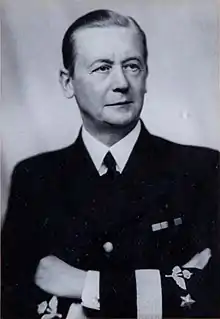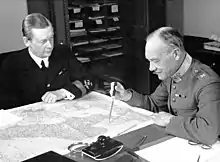Torsten Friis
Lieutenant General Torsten Friis (1 August 1882 – 21 April 1967) was a Swedish Air Force officer. Friis was initially a fortification officer and was commanding officer of the Field Telegraph Corps from 1928 to 1932 and chief of the Military Office of the Land Defence from 1932 to 1934. In 1934 he was commissioned to build the Swedish Air Force and was appointed Chief of the Air Force, a position he held until 1942 when he retired.
Torsten Friis | |
|---|---|
 Friis circa 1942. | |
| Born | 1 August 1882 Malmö, Sweden |
| Died | 21 April 1967 (aged 84) Järfälla, Sweden |
| Allegiance | Sweden |
| Service/ | Swedish Air Force |
| Years of service | 1902–1942 |
| Rank | Lieutenant General |
| Commands held | Field Telegraph Corps Military Office of the Land Defence Chief of the Air Force |
Early life
Friis was born on 1 August 1882 in Malmö, Sweden, the son of vice consul Ernst Friis and his wife Sophie (née Thomée)[1] and brother of rear admiral Helge Friis (1883–1956).[2] He passed studentexamen in 1900.[1]
Career
Friis was commissioned as an officer 1902 and was given the rank of underlöjtnant the same year. Friis became lieutenant in the Royal Swedish Fortification (Kungliga Fortifikationen) in 1907 and graduated from the Artillery and Engineering College in 1908. Friis was promoted to captain in 1913 and served in the campaign with the Austro-Hungarian Army in 1916. He was a teacher at the Royal Swedish Army Staff College from 1918 to 1919 and at the Artillery and Engineering College from 1919 to 1921 and served as adjutant to the Crown Prince from 1920 to 1932.[1] He became captain in the General Staff in 1921 and major in the General Staff in 1922.[3]

Friis was head of department at the General Staff's Technical Department from 1922 to 1927 and was lieutenant colonel in the General Staff in 1926 and became a lieutenant colonel in the Royal Swedish Fortification in 1928. He was commanding officer of the Field Telegraph Corps from 1928 to 1932 and was promoted to colonel in the Field Telegraph Corps in 1932. Friis was chief of the Military Office of the Land Defence from 1932 to 1934 and became major general in the Swedish Air Force in 1934.[3] In April 1934, the then Chief of the Air Force major general Eric Virgin applied for a year's leave of absence, after Virgin and the Abyssinia government entered an agreements to which Virgin would function as chief adviser of the reorganization of the country's army.[4] Friis took over as Chief of the Air Force and was promoted to lieutenant general in 1936.[3]
Friis was determined to make the Air Force as equal and effective weapon as one of the older military branches. Because of this he needed an Air Staff, which was also created by the Defence Act of 1936. The Air Force lacked a staff and pilot trained officer who could be appointed chief of staff. Friis therefore offered Bengt Nordenskiöld this position.[5] Nordenskiöld often expressed opinions and criticism in an arrogant and hurtful way. He was often on matters of fact superior to his subordinates and opponents, but he found it difficult to acknowledge others work and listen to their arguments. Thereby he sometimes counteracted the Air Force interests, and he compromised at times that particular work satisfaction and the cohesion he sought. This prompted the defense minister Per Edvin Sköld and the Supreme Commander Olof Thörnell in 1942 to appeal to Friis to remain as Chief of the Air Force. Although Friis shared Sköld's and Thörnell's opinion on Nordenskiöld, Friis felt that Nordenskiöld had to succeed him if the Air Force would be able to keep up with the ever-accelerating development.[5]
Friis left the position as Chief of the Air Force in 1942[1] and was placed in the reserve the same year. He was then governor (ståthållare) of Drottningholm Palace, Gripsholm Castle, Haga Palace, Rosersberg Palace, Stockholm Palace, Strömsholm Palace, Tullgarn Palace and Ulriksdal Palace from 1947 to 1962.[6][7][2] Friis was standard-bearer of the Orders of His Majesty the King (Kungl. Maj:ts Orden) from 1949[8] and head of the Royal Djurgården Administration (Kungliga Djurgårdens Förvaltning) from 1949 to 1962.[6][2] Friis became a member of the Royal Swedish Academy of War Sciences in 1924[3] and was board member of Royal Automobile Club.[1]
Personal life
In 1909 he married Lotty Salin (1887–1968), the daughter of professor Mauritz Salin and Bertha (née Kempe).[6] Friis was the father of Birgit (born 1910), Lotty (born 1914) and Bertha (1923–1997). Friis was the father in law of colonel Sven Thofelt (married to Birgit), doctor Ole Berg (married to Lotty) and count Karl-Hampus Mörner (married to Bertha). The Friis' acquired the Görväln House in 1937 where they lived until their death in 1967 and 1968.[9]
Dates of rank
- 1902 – Underlöjtnant
- 1907 – Lieutenant
- 1913 – Captain
- 1922 – Major
- 1926 – Lieutenant colonel
- 1932 – Colonel
- 1934 – Major general
- 1936 – Lieutenant general
Awards and decorations
Swedish

 King Gustaf V's Jubilee Commemorative Medal (1948)[10]
King Gustaf V's Jubilee Commemorative Medal (1948)[10]
 King Gustaf V's Jubilee Commemorative Medal (1928)[3]
King Gustaf V's Jubilee Commemorative Medal (1928)[3]
 King Gustaf V's Commemorative Medal (1951)[11]
King Gustaf V's Commemorative Medal (1951)[11]
 Commander Grand Cross of the Order of the Sword (16 June 1937)[12]
Commander Grand Cross of the Order of the Sword (16 June 1937)[12]
 Knight of the Order of the Sword (1923)[13]
Knight of the Order of the Sword (1923)[13]
 Commander Grand Cross of the Order of the Polar Star (31 December 1949)[14]
Commander Grand Cross of the Order of the Polar Star (31 December 1949)[14]
 Knight of the Order of the Polar Star (1933)[3]
Knight of the Order of the Polar Star (1933)[3]
 Knight of the Order of Vasa (1926)[3]
Knight of the Order of Vasa (1926)[3]
Foreign

 Grand Cross of the Order of the Dannebrog (before 1955)[11]
Grand Cross of the Order of the Dannebrog (before 1955)[11]
 Commander 1st Class of the Order of the Dannebrog (1935)[3]
Commander 1st Class of the Order of the Dannebrog (1935)[3]
 Commander of the Order of the Dannebrog (before 1931)[15]
Commander of the Order of the Dannebrog (before 1931)[15]
.svg.png.webp) Grand Cross of the Order of the Star of Ethiopia (before 1955)[11]
Grand Cross of the Order of the Star of Ethiopia (before 1955)[11]
 Commander 1st Class of the Order of the White Rose of Finland (1934)[3]
Commander 1st Class of the Order of the White Rose of Finland (1934)[3]
 Grand Cross of the Order of the Lion of Finland (before enast 1962)[16]
Grand Cross of the Order of the Lion of Finland (before enast 1962)[16] Finnish Air Force's Aviation Badge (1938)[3]
Finnish Air Force's Aviation Badge (1938)[3]
 Commander of the Legion of Honour (1937)[3]
Commander of the Legion of Honour (1937)[3]_-_Sash.svg.png.webp)
.svg.png.webp) Grand Cross of the Order of Homayoun (before 1962)[16]
Grand Cross of the Order of Homayoun (before 1962)[16]
.svg.png.webp) Grand Cross of the Order of the Crown of Italy (1945)[1]
Grand Cross of the Order of the Crown of Italy (1945)[1]
 Commander 1st Class of the Order of Vytautas the Great (1935)[3]
Commander 1st Class of the Order of Vytautas the Great (1935)[3]
 Grand Cross of the Order of the House of Orange (before 1962)[16]
Grand Cross of the Order of the House of Orange (before 1962)[16]
 Grand Cross of the Order of St. Olav (before 1955)[11]
Grand Cross of the Order of St. Olav (before 1955)[11]
 Commander with Star of the Order of St. Olav (1936)[3]
Commander with Star of the Order of St. Olav (1936)[3]
 Commander of the Order of St. Olav (before 1931)[15]
Commander of the Order of St. Olav (before 1931)[15]
 Commander's Cross with Star of the Order of Polonia Restituta (1934)[3]
Commander's Cross with Star of the Order of Polonia Restituta (1934)[3] Polish Air Force's Aviation Badge (1936)[3]
Polish Air Force's Aviation Badge (1936)[3]
 Grand Cross of the Royal Victorian Order (before 1962)[16]
Grand Cross of the Royal Victorian Order (before 1962)[16]
.svg.png.webp) Grand Cross of the Order of the German Eagle (1938)[3]
Grand Cross of the Order of the German Eagle (1938)[3]
References
- Harnesk, Paul, ed. (1945). Vem är vem?. D. 1, Stockholmsdelen [Who is Who?. D. 1, Stockholm part] (in Swedish). Stockholm: Vem är vem bokförlag. p. 231.
- "Friis, släkt". Svenskt biografiskt lexikon (in Swedish). Vol. 16. National Archives of Sweden. 1964–1966. p. 567. Retrieved 2017-03-08.
- Gierow, Krister, ed. (1940). Skåningar i Stockholm (in Swedish). Malmö: Skånetr:s förl. p. 173. SELIBR 1376692.
- Kjellberg, H. E., ed. (1934). Svenska dagbladets årsbok TOLFTE ÅRGÅNGEN (Händelserna 1934) (in Swedish). Stockholm: Svenska Dagbladet. p. 23. SELIBR 283647.
- Böhme, Klaus-Richard (1990–1991). "Bengt G Nordenskiöld". Svenskt biografiskt lexikon (in Swedish). Vol. 27. National Archives of Sweden. p. 292. Retrieved 2017-03-08.
- Burling, Ingeborg, ed. (1962). Vem är det: svensk biografisk handbok. 1963 [Who is it: Swedish biographical handbook. 1963] (in Swedish). Stockholm: Norstedt. pp. 332–333.
- Sveriges statskalender för året 1950 (in Swedish). Stockholm: Fritzes offentliga publikationer. 1950. pp. 65–66.
- Sveriges statskalender för året 1950 (in Swedish). Stockholm: Fritzes offentliga publikationer. 1950. p. 7.
- Selling, Gösta (1977). Säterier och gamla gårdar i Stockholmstrakten (in Swedish) (Ny, omarb. och väsentligt utvidgad ed.). Stockholm: Bonnier. p. 95. ISBN 91-0-039434-3. SELIBR 7144379.
- Sveriges statskalender för året 1950 (in Swedish). Stockholm: Fritzes offentliga publikationer. 1950. p. 61.
- Sveriges statskalender för året 1955 (in Swedish). Stockholm: Fritzes offentliga publikationer. 1955. p. 62.
- Sveriges statskalender för skottåret 1940 (in Swedish). Uppsala: Fritzes offentliga publikationer. 1940. p. 1940.
- Sveriges statskalender för året 1925 (in Swedish). Uppsala: Almqvist & Wiksell. 1925. p. 830.
- Sveriges statskalender för året 1950 (in Swedish). Stockholm: Fritzes offentliga publikationer. 1950. p. 51.
- Sveriges statskalender för året 1931 (in Swedish). Uppsala: Fritzes offentliga publikationer. 1931. p. 307.
- Harnesk, Paul, ed. (1962). Vem är vem? [Who's Who?] (in Swedish). Vol. 1, Stor–Stockholm (2nd ed.). Stockholm: Vem är vem bokförlag. p. 414. SELIBR 53509.